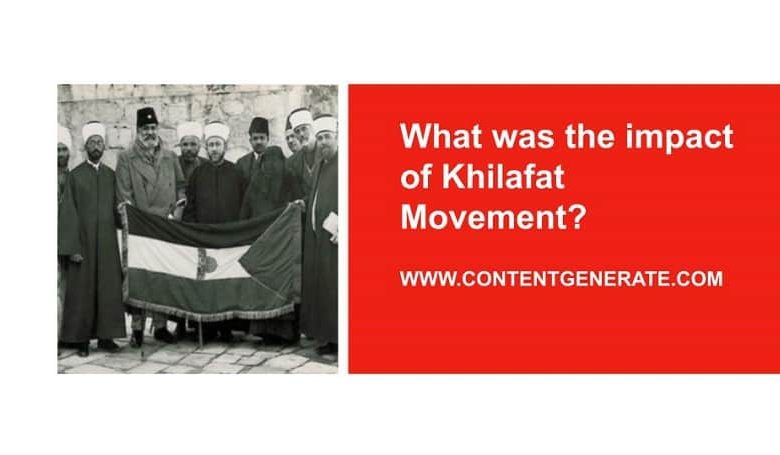Impact of Khilafat Movement on Life of Indian Muslims

This post discusses the impact of the Khilafat Movement on the life of Muslims of the Indian subcontinent.
Contents
Background
Khilafat Movement was a protest movement of Indian Muslims, launched for the protection of the Ottoman Empire and its territorial integrity at the end of World War I. Indian National Congress and its leader Mahatma Gandhi also supported the Khilafat Movement paving way for Hindus’ support to the movement. The movement started in 1919 and ended in 1924 with the abolishment of the position of Khalifa by the new government of Mustafa Kemal Ataturk in Turkey.
The positive impact of the Khilafat Movement
1. Emergence of political leadership
Khilafat Movement provided a platform for Indian Muslims to speak against the British in India. For the first time after 1857, Muslims all over India started taking part in protest rallies, sit-ins, and mass gatherings.
The movement led to the emergence of a new young political leadership that now has the required know-how about the political agitation and tactics to use later during the Pakistan Movement.
2. Use of experience in Pakistan Movement
The movement provided Muslims an opportunity for political involvement and to get hands-on experience. Muslims used the experience of the movement later in the struggle for the achievement of a separate homeland for Muslims of the Indian subcontinent.
3. Realization of their power
By this time, the Muslims had come to the realization that if they acted together they could pressure the government in their favor. They realized that together they become powerful enough to force the British to talk to them. Thus the lesson that Muslims learned was, ‘by only creating unity among themselves they could protect their rights and interests.
4. First-time political activity after 1857
It was the first major political mobilization of Indian Muslims after the 1857 revolt against the British. The colonizers pointed out Muslims and held them responsible for the conflict. They ruthlessly oppressed Muslims.
Being defeated in the war, the Muslims were not in a position to confront the British with the same resistance again. The Khilafat Movement broke the ice and encouraged Muslims to demonstrate. People fully participated in the movement and resisted the British with all force all over India.
5. Unity among Muslims
Before Khilafat Movement, Muslims were scattered and never came together for a common cause. Khilafat Movement provided a stage for Muslims of the Indian subcontinent to raise their voice by bringing them closer to each other. In other words, the movement united Muslims of India after a long time.
6. Hindu-Muslim Unity
The support from the Congress and Gandhi’s role as chief organizer of the Movement created an environment of Hindu-Muslim unity. For the time being, the differences between both of the communities got aside. Both Hindus and Muslims started acting against the British in unity first time after the war of 1857. Thus, an atmosphere of cordiality, goodwill, cooperation, and mutual respect between both of the communities prevailed as long as Gandhi supported Khilafat Movement.
The negative impact of the Khilafat Movement
1. Economic loss
Muslims had to face economic problems and losses because of Khilafat Movement. Many had resigned from government jobs. Now after the movement, they faced unemployment and economic stress.
Around 18000 poor peasants had migrated to Afghanistan as some of the Muslim clerics declared India Darul Harb. The migrating peasants, when reached Afghanistan, the Afghan officials sent them back instead of well coming them. These migrants had sold their lands, property, and everything they owned. When they came back, they had nothing on which they could live a decent life.
2. Educational loss
In view of the call from Khilafat Movement leadership, Muslims boycotted English, government schools, courts. elections, etc. The boycott of schools adversely impacted the education of Muslim children. In effect, Muslims faced difficulty to re-admit them at the school and ensure the continuity of education of their children.
3. Torture and murder
In order to control the situation, the British government arrested tens and hundreds of activists and put them in jails under the notorious Rowlatt Act, 1919. In addition, many people died during disturbances as police cracked down whereas many died in jails while serving long long, and life sentences. As a result of life sentences and killings, many families had to suffer economically as their bread earners rotted in jails.


